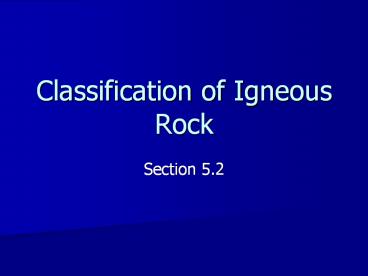Classification of Igneous Rock - PowerPoint PPT Presentation
Title:
Classification of Igneous Rock
Description:
Classification of Igneous Rock Section 5.2 Mineral Composition Intrusive Igneous intrusion Large crystals (macroscopic) Extrusive Lava flow or flood basalts Small ... – PowerPoint PPT presentation
Number of Views:283
Avg rating:3.0/5.0
Title: Classification of Igneous Rock
1
Classification of Igneous Rock
- Section 5.2
2
Mineral Composition
- Intrusive
- Igneous intrusion
- Large crystals (macroscopic)
- Extrusive
- Lava flow or flood basalts
- Small crystals (requires magnification)
3
Mineral Composition
- Basaltic rocks
- Dark colored
- Lower silica content
- Contain mostly plagioclase and pyroxene
- Granite rocks
- Light colored
- High silica content
- Contain mostly quartz, K plagioclase feldspar
4
Mineral Compositions
- Intermediate rocks have a composition of minerals
between baslatic and granite rocks - Ultrabasic rocks
- Contain only iron-rich minerals
- Always dark
5
Texture
- Texture refers to the size, shape, and
distribution of the crystals or grains that make
up a rock - Rhyolite fine-grained
- Granite coarse-grained
- How is crystal size affected by cooling rate?
6
Texture
- Porphyritic texture large well formed crystals
surrounded by finer grained crystals of the same
or different mineral - Forms when slowly cooling magma suddenly cooled
rapidly - Vesicular texture spongy appearance Pumice is
an example
7
Thin Sections
- A slice of rock usually 2cm X 4 cm and only 0.03
mm thick - Light is able to pass through it
- A petrographic microscope is used to view thin
sections
8
Veins
- Valuable ores occur within igneous intrusions
Ores also occur in the rocks surrounding
intrusions called veins - Important metallic elements include gold, silver,
lead, and copper
9
Pegmatites
- Pegmatites veins of extremely large-grained
minerals - Lithium and Beryllium ores form in pegmatites
- Produce beautiful crystals
- Mount Rushmore in South Dakota
10
Kimberlites
- Kimberlites are ultrabasic rocks
- Form at depths of 150 to 300 km
- Named for Kimberly, South Africa
- Diamonds form in kimberlites
- Where in the US have kimberlites been found?
11
Construction Uses
- Interlocking grain textures make igneous rocks
strong - Resistant to weathering
- Granite is used in countertops, floors, and
statues































